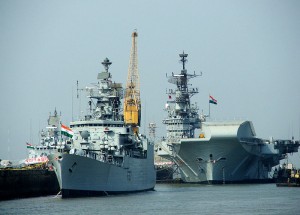by Dr. Micha’el Tanchum
EXECUTIVE SUMMARY: India regards China’s efforts to enhance its naval presence in the Indian Ocean as undermining New Delhi’s strategic position. As a response, India has beefed up its naval capabilities, increasing the likelihood of India joining the naval coalition of Australia, Japan, and the US.

BESA Center Perspectives Paper No. 233
The Indian defense establishment commonly regards China’s efforts to enhance its naval presence in the Indian Ocean as an attempt to undermine its strategic position in India’s “near abroad.” While a minority view holds that China merely seeks to expand its commercial reach, Beijing’s actions may suggest otherwise. Its construction of deep-water ports and securing of usage agreements for naval and maritime installations along the sea lanes from China to the Persian Gulf, dubbed the “String of Pearls,” is widely viewed in New Delhi as tantamount to China’s strategic encirclement of India.
India’s Naval Upgrades
In response to the perceived threat, India has embarked on developing a blue-water navy, based on a strategy of building three carrier battle groups that will project power far from its shores and enable New Delhi to partner on more equal footing with Asia’s major naval powers. Thus, the scheduled arrival of India’s second aircraft carrier from Russia in late January 2014, the INS Vikramaditya, has been celebrated as the symbol of India’s growing naval power, as the new ship will make India’s navy Asia’s only fleet with two aircraft carriers. The 45,400 ton Vikramaditya is significantly larger than any Indian naval vessel, and boasts some of the most advanced combat capabilities with its ten Kamov-31 helicopters and 24 MiG 29K fighters. This addition will enable the Indian Navy to achieve a strategic goal of operating full carrier battles concurrently in its western and eastern theaters of operation.Despite the fanfare, India’s most strategically significant advance in naval strength may actually be its acquisition of 12 P-81 antisubmarine warfare (ASW) aircraft, a variant of Boeing’s P-8A Poseidon ASW aircraft developed for the US Navy. The P-81 fleet – which will make India the first country other than the US to possess the sophisticated, long-range ASW aircraft – represents an important step in India’s efforts to diversify its naval acquisitions beyond its traditional Russian supplier. The new fleet will ease interoperability with US naval forces and could help India move closer to participating in the important Trilateral Security Dialogue (TSD) with Australia, Japan, and the US. The Indian Navy has already successfully tested the aircraft’s ASW capabilities as well as its Boeing Harpoon Block II missiles, which can lethally strike coastal defense facilities, surface-to-air missile sites, port facilities, and ships in port. Furthermore, the P-81 fleet offers India the potential to implement aspects of an Air-Sea Battle (ASB) concept to counter China’s Anti-Access/Area Denial (A2/AD) capabilities, which seek to prevent an adversary from amassing superior naval force in a location deemed important to Chinese national interests.
Countering Regional Threats
India’s P-81 fleet will certainly give New Delhi a distinct naval advantage over Islamabad, as Pakistan’s navy possesses only four of the much older and far inferior P-3Cs. Even more significantly, the long-range P-81s give India the potential to exercise some degree of sea control against Chinese efforts to extend its A2/AD capabilities in the Indian Ocean and South China Sea.With 79 principal surface ships and approximately 60 submarines, China possesses the largest naval arsenal of any Asian nation. Nonetheless, for the time being, the Chinese navy is lacking sophisticated ASW and anti-aircraft capabilities, and thus cannot provide its vessels a reasonable measure of security in open seas. In response to this and other weaknesses vis-à-vis the US naval presence in Asia, Beijing has developed the aforementioned A2/AD counter-intervention strategy. In response, Washington developed its doctrine of Air-Sea Battle (ASB) to defend the free access of international commercial sea lanes upon which global trade depends. The ASB strategy is designed to be an effective countermeasure should Beijing decide to forcefully change the status quo and establish an A2/AD presence in disputed areas over which it claims sovereignty. India’s new P-81 fleet, in combination with its two carrier battle groups, will allow it to develop its own limited ASB strategy to counteract Chinese A2/AD capabilities near India’s eastern shores and economic interests in the South China Sea. New Delhi may also be able to conduct larger joint ASB operations with Tokyo as part of the burgeoning Indo-Japanese naval cooperation, or in an even wider coalition with the TSD.
Conclusion
India’s naval upgrades enhance its ability to project power over longer distances to counteract A2/AD tactics, making New Delhi more of a player in the South China Sea. Considered together with the fact that India will now be able to regularly deploy a carrier battle group in its eastern theater of operations without fear of vulnerability in the west, India’s regional power projection has become a permanent factor in any strategic calculus to change the status quo in the Indo-Pacific.BESA Center Perspectives Papers are published through the generosity of the Greg Rosshandler Family
(Photo Credit: Wikimedia)
Dr. Micha’el Tanchum is a fellow in the Department of Middle East and Islamic Studies at the Shalem Center in Jerusalem and the Hebrew University’s Truman Institute for the Advancement of Peace. He also teaches in Tel Aviv University’s Department of East Asian Studies.
Source: http://besacenter.org/perspectives-papers/india-advances-naval-arms-race-china/
Copyright - Original materials copyright (c) by the authors.
No comments:
Post a Comment